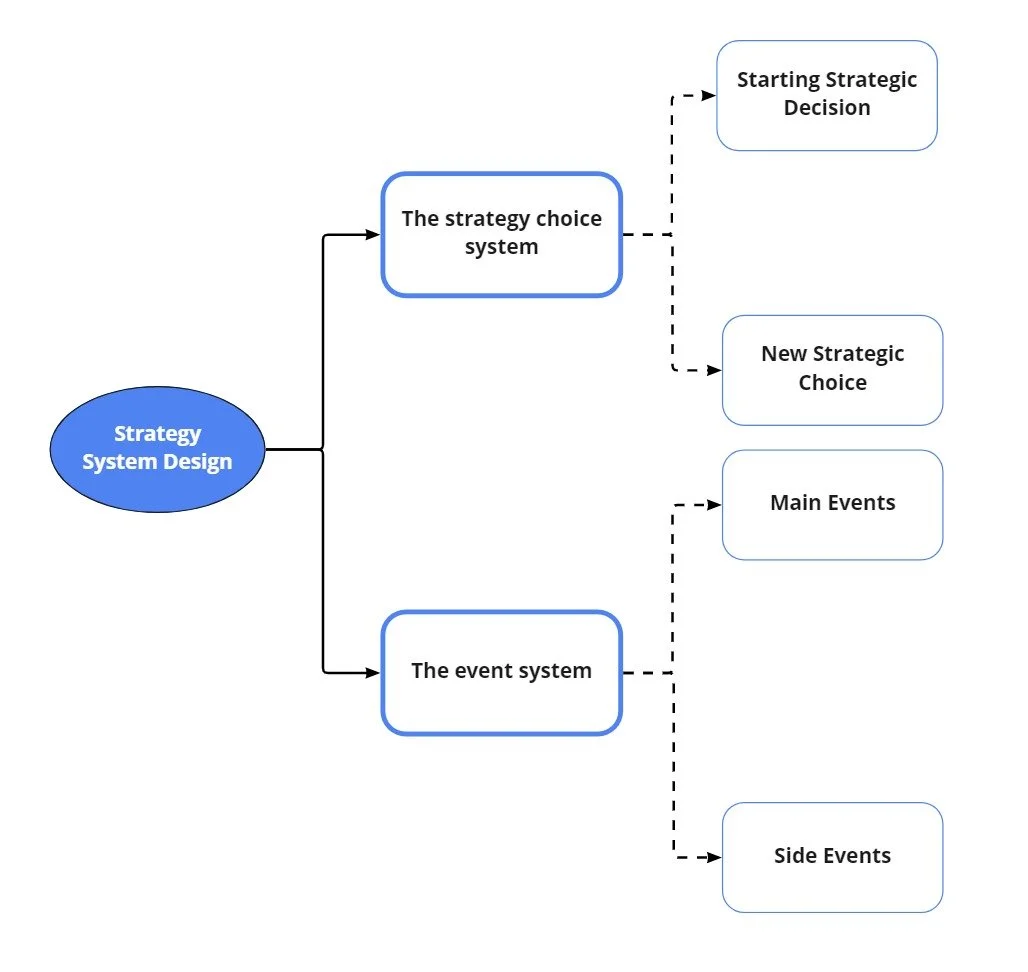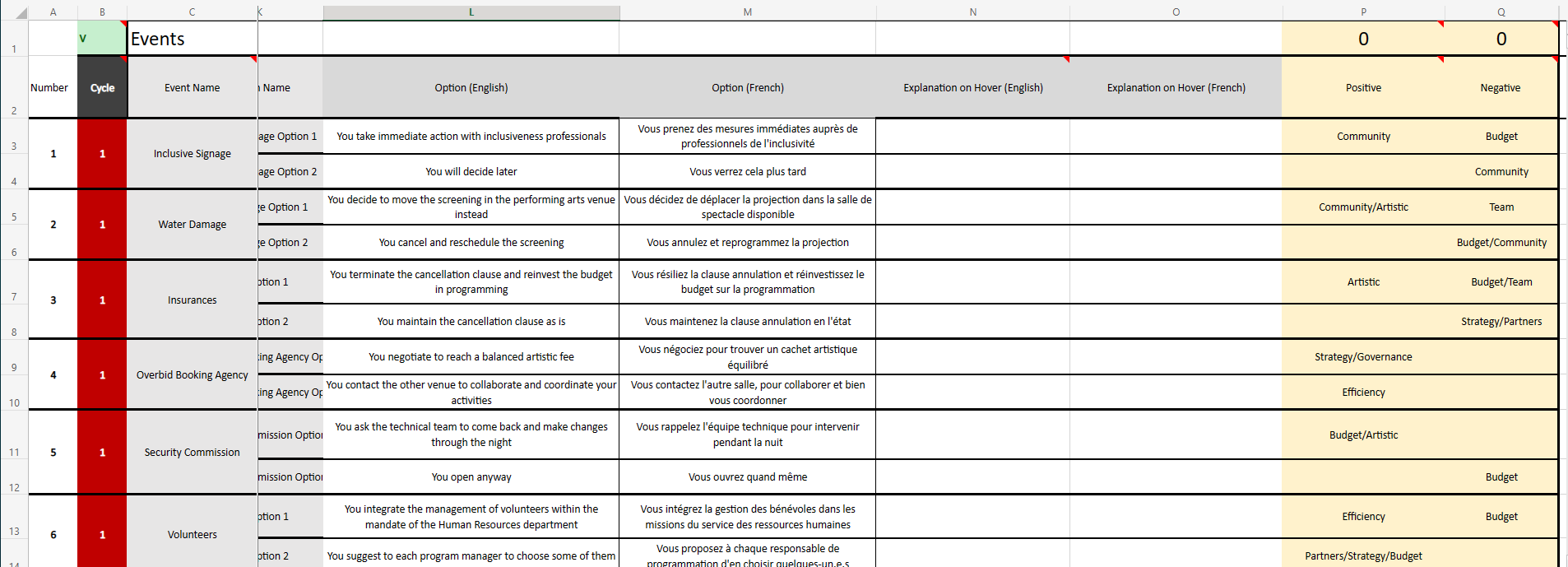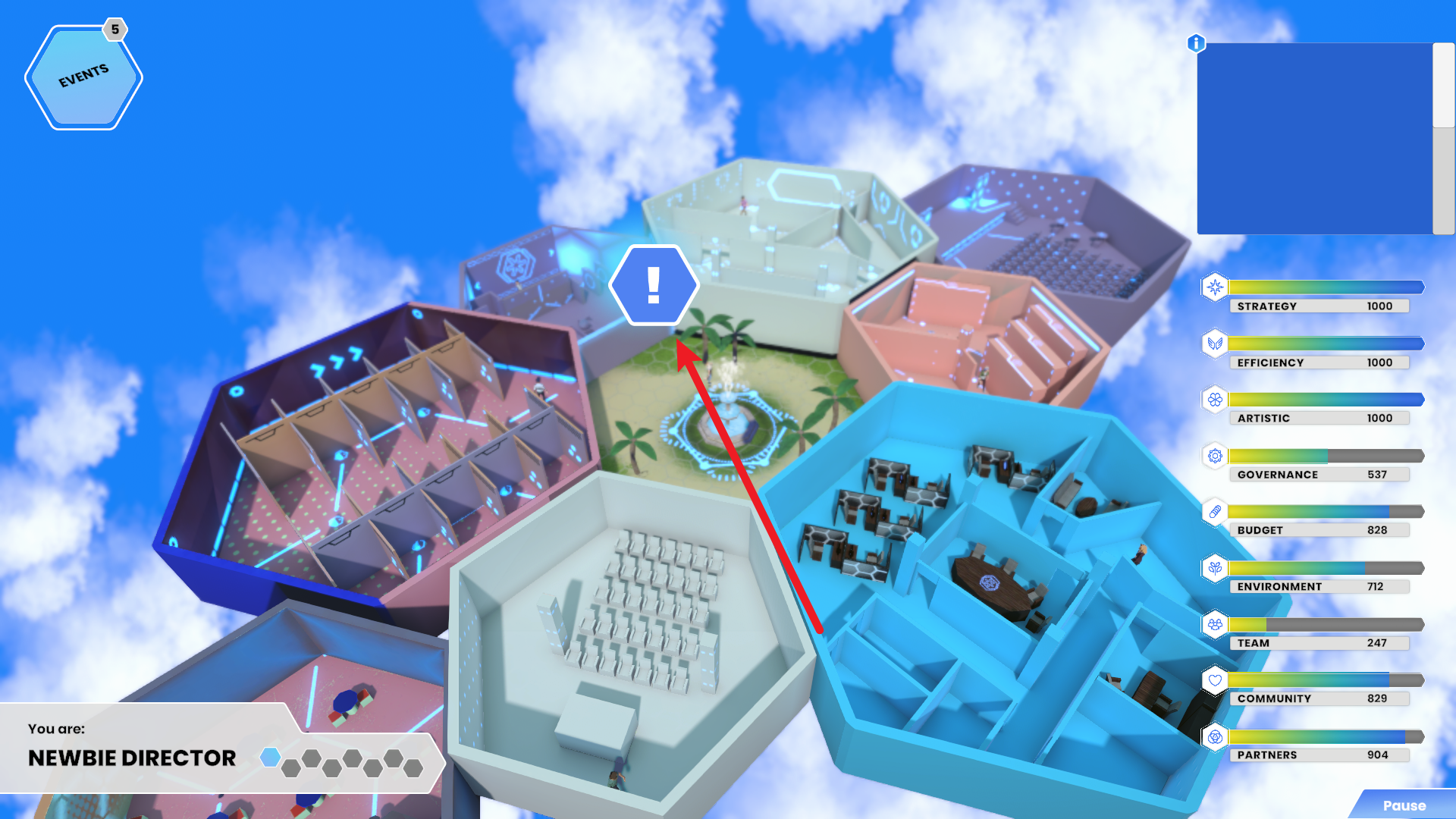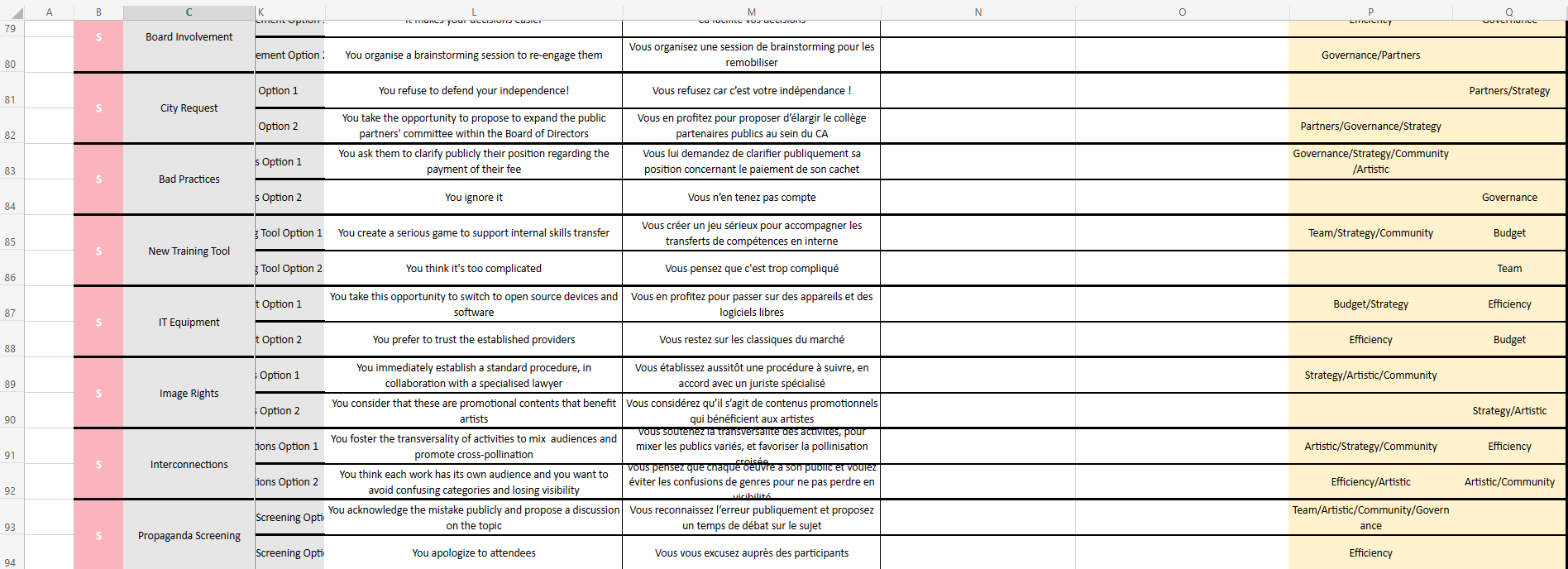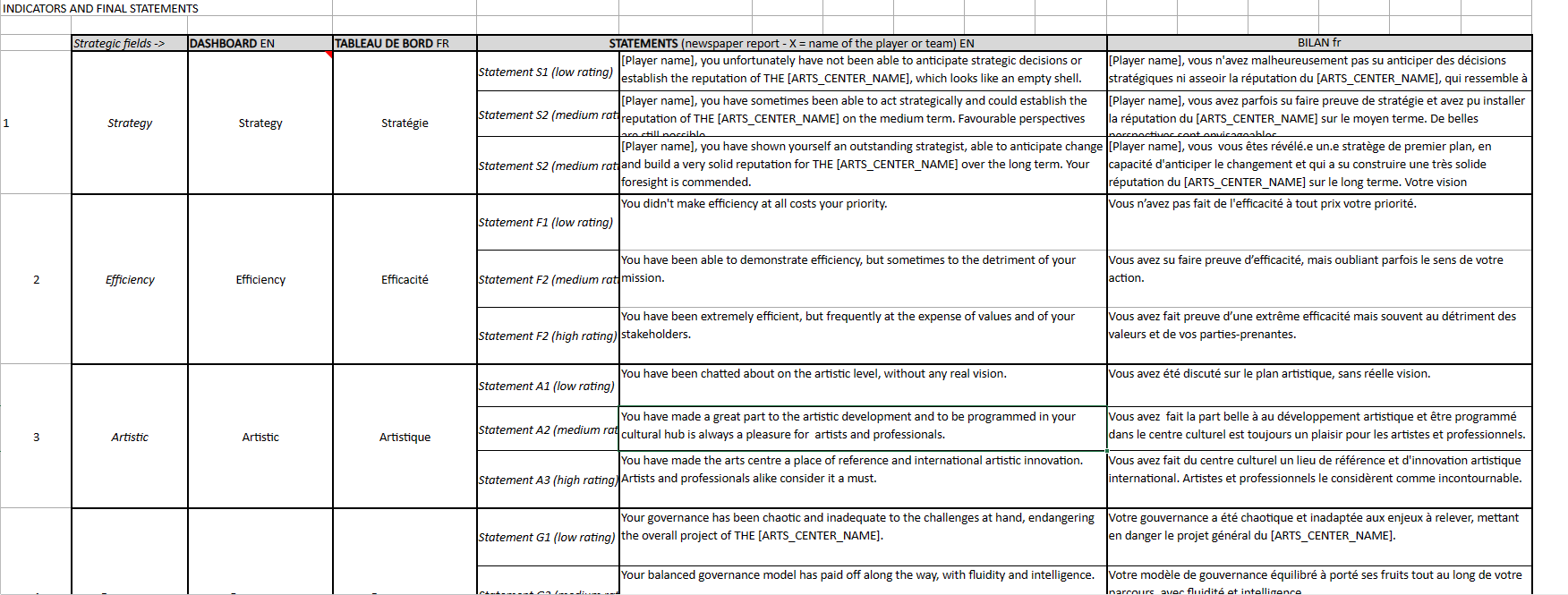is a digital simulation serious game that explores the skills and strategies required for managing artistic production and presentation venues.
Team
Mars Balisacan, Asher Gao, Kennedy Kan, Sofie Vang Nielsen, Jisoo Shin, Chali Termpaiboon
Platform
Windows, MacOS, HTML5
My Role
Game Designer & UX Designer
Duration
3 Month
Engine
Unity
Genre
Serious Game, Strategic, Simulator, Educational
Target Players
Culture professionals and leaders
Overview
Future Arts Centre is a multi-platform serious strategic simulator game that provides diverse scenarios and management cycles within a fictional multidisciplinary arts center.
Players are engaged in strategic decision-making of the cultural space of an art centre, shaping its appeal and relatability to audiences, communities, and stakeholders. As managing an art centre’s operations is never easy, players will need to rely on their resources and cultural understanding of the creative and professional space to be able to address events and issues they might encounter as they progress through the game.
My Duty
On Future Arts Centre, I was Game Designer and UX Designer. My duties included:
Pitch gameplay features and ideas
Designed game system and gameplay mechanics, including event systems with different weights, rewards system, achievement system, and multi-branching endings etc.
Created and filled out spreadsheets of game events system, iterated and updated based on player’s feedback and developer’s technical needs.
Applied Unity engine UGUI capabilities to create game user interfaces
Participated in internal and external playtesting, summarized problems and proposed solutions
Demo Reel
Game Flow
The entire game can be broken down into three large sections:
The beginning:Including basic information introduction and starting strategy decisions
Core game cycle:Including 8 game cycles, each including main events and side events, with an event with social impact and new strategic choice as the end of each cycle
Summary:Including multi-branch endings and achievements for the player
Game System Design
“How to let players feel immersive in the introduction stage of the whole game?”
Considering that the audience for this game is cultural professionals, I employ the design principle of starting with a familiar scenario: receiving a job offer and commencing one's role as the director of an art center.
There are two main reasons for this design:
Realism: It aligns with the actual hiring process, reducing the learning cost for players, particularly those new to the game.
Engagement: The use of emails and conversations adds a lively and interesting element to the player's experience.
“What factors are taken into consideration when designing the game's strategy system”
In the game, the player takes on the role of a newly appointed diretor of an art center. After thorough research, I divided the game's strategy system into two main parts:
The Strategy Choice System: Comprising 'Starting Strategic Decisions' and 'New Strategic Choices.
The Event System: Consisting of 'Main Events' and 'Side Events.'
When designing the game's strategy system, I first considered "realistic" and "instructive" . I aimed to incorporate real-life situations, challenges, and daily tasks encountered by cultural professionals into the game. This approach allows players to learn from their in-game experiences and better understand their roles.
Design of the Strategy Choice System
After completing the introduction phase and formally entering the game, the player will first start with the "Starting Strategy Decision" phase.
As a newly appointed director of an art center, the player needs to choose one option from each of the two available themes. Each choice impacts an associated indicator, which updates in real-time. After confirming their choices, the game provides an overall summary, allowing players to review their art center's values from a macro perspective.
This phase serves as a 'pre-planning' stage in the strategy choice system, focusing on players' strategic vision and offering a broader perspective on art center management through choices across five categories.
In the game's eight cycles, at the end of the first seven, an 'Event with Social Impact' occurs, impacting the art center's operation. Players then enter the 'New Strategic Choice' phase to adapt to the situation.
This phase serves as a 'quick adjustment' in the strategy choice system, reflecting how real art center strategies adapt to societal changes.
It introduces new variables for players, encouraging players to review and adjust their strategies, enhancing game realism and player experience.
Starting Strategy Decision
New Strategic Choice
Design of the Event System
The event system is a significant component of the game's strategy system.
In each of the eight cycles, players encounter a specific number of main events. They read event descriptions and make choices between two options, with each option affecting associated indicators in real-time.
The two available choices for players aren't categorized as 'good' or 'bad' options in the traditional sense. There's no single 'optimal choice.'
For instance, selecting a high-level conference with a foreign researcher boosts the 'Artistic' aspect of the art center but decreases 'Community' and 'Budget.' Conversely, promoting an open consultation meeting increases 'Community' and 'Budget' but reduces the 'Artistic' aspect."
With this design, I aim to empower players with choices, encouraging them to consider what arts centers require to prosper in the future.
Design of main events
Unlike the "main events", the "side events" are designed to introduce unexpected or emergency situations in the game.
These side events typically have negative implications and must be resolved immediately for the game to continue.
Main Events
Side Events
From a game designer's perspective, 'main events' simulate the routine responsibilities of an art center director in the game. Players face a range of choices related to art center operations, making decisions based on the situation details.
Side events are not triggered based on a fixed method like main events. Instead, when the value of an indicator falls below one-third, the corresponding side event is triggered.
As with main events, there are no 'good' or 'bad' options for players when it comes to side events. In other words, there is no single 'best option.'
Design of side events
“How to show the growth of the player in a visual way?”
In the game, players take on the role of a newly appointed CEO of a brand-new art center, making strategic decisions and responding to global and local events across eight game cycles spanning ten in-game years. In reality, a character with such a long tenure would naturally experience growth and learning from their experiences.
So, I designed an upgrade interface at the end of each game cycle, following the player's strategy adjustments in response to impactful events. This interface signifies the player's growth, indicating them as a more experienced director.
From a UX perspective, I focus on designing various interfaces that visually represent player growth.
The End of Cycle 1 : Novice Director
The End of Cycle 7 : Legendary Director
Upgrade Interface at the End of Each Game Cycle
Progress Bar at the Main Screen
I designed a progress bar, always visible in the bottom right corner of the main game screen.
This serves two purposes:
Displays the player's current stage and reflects their growth by comparing before and after
Reminds players of the overall game progress
Cycle 1 : Newbie Director
Cycle 8 : Legendary Director
“Why you choose to design multiple ending system and achievement system?”
This approach encourages players to revisit the game multiple times, either individually or with others, with the mindset of 'I'll do better next time' or 'I'll try something different next time.' This aligns with the serious game's educational purpose: promoting skill development and supporting the cultural sector's ecosystem change perspective.
At the end of all eight game cycles, the game reaches its conclusion.
Both systems were designed with a shared goal: enhancing the game's replayability.
Ending Statement: Low Efficiency
Ending Statement: Medium Efficiency
Multiple Ends
Achievement System
In the game, achievements are visualized as trophies awarded to players at the end.
Summary of Trophy that Players Get
Detail Information of the Trophy
The ending is determined by the values of various indicators, with different indicator values corresponding to different ending statements.
In the game's narrative, the player, as the director, departs from the art center after more than ten years of dedication. The game presents the ending to the player through a local newspaper article
There are nine trophies, each corresponding to one of the nine game indicators. If a certain indicator falls within the 'HIGH' range at the end, the player earns the corresponding trophy.
Correspondence between indicators and trophies
Requirements to win the trophy
Project Takeaways
In game design, mechanics form the skeleton, and content is the flesh and blood. A successful game requires a harmonious blend of both, as the absence of either during the design phase significantly hinders overall game development.
When developing games for clients, it's essential to allocate time and resources to handle unexpected client-side situations
Effective game development relies on strong project management. Game designers should also acquire team management skills and maintain open communication with artists and developers.











